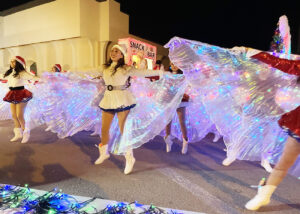By Karen Gleason
The 830 Times
City council members have given the go-ahead for the next step in the city’s search to find at least one alternate water source.
The council took action on the issue during its regular meeting on Tuesday, April 23.
Assistant Public Works Director Greg Velazquez spoke to the council about the ongoing project.
“So our last presentation (on April 16) was in regards to drilling some test well sites at the archery range located just north of the West Springs and the golf course. The plan is to do planning and coordination and do the geophysical survey. The technology we plan on using is electrical resistivity tomography, which basically is telling you an exact area where we can find the amount of water that we need to subsidize (the city’s current water supplies) and bring (that water) either to our water treatment plant or directly to the distribution line that goes to the Bedell (water) tanks,” Velazquez told the council.
“So what we’re requesting, in order for us to move forward, (is) direction from council to start performing this preliminary study, not just go out there and drill anywhere. The preliminary study is to make sure we identify the right location, pinpoint that location and then move forward with coming back with a request for proposals for test drilling,” Velazquez said.
“So we’d like to request that motion from council and directive to move forward,” Velazquez added.
Mayor Pro-tem Steve Webb said he had a question after Velazquez finished.
Webb said, “We started discussing a second well over two years ago. It was brought to us that we needed a second water source. At that time did we do anything to look into a second water source? Or was it just a discussion and dropped?”
“As to the location where we want to drill now?” Velazquez asked.
“No, because we had other water sources (that we discussed), Hamilton, Agarita, and we looked at all that, and we started doing water testing and everything to see if it was viable water to use, and all of a sudden those projects stopped, and here we are now in a critical condition, conserving water, and it could even get worse, and we want to spend the next 18 to 24 months trying to figure out if we can get a second well,” Webb said.
Velazquez said the Texas Commission on Environmental Quality (TCEQ) requires 18 to 24 months of testing for a new well to be used in a public water system and provided a detailed explanation of what those tests entail.
“So what you want to do right now is get permission to drill on this property and see if there’s water there that is viable to use, and we’re going to end up with another 18 to 24 months waiting on all the tests to be done and see if it is?” Webb asked.
“During an emergency situation, if we fall under an emergency situation, you get temporary authorization from TCEQ, even if you’re testing. If it comes back and we determine whichever, groundwater or GUI, if it’s groundwater, you do testing, but it’s simpler to just add disinfection, disinfect it and send it to distribution. In the case that it’s a GUI, since you already have a treatment plant, about 1,500 feet from the archery range, it’s going directly to membrane filtration, therefore that is completely out. You just go straight to treatment,” Velazquez replied.
“I wish we would have started doing whatever back when we first discussed it, because we told everybody during our discussions that we were going to need that well. No matter where we put it, we were going to need it sooner or later. Here we are later, and now we’re talking about drilling, and that’s just not good for the community,” Webb said.
“I agree. I have been here for 26 years, and this has been brought up many, many times. . . So as a public servant, it’s our best interest to do the best for the city of Del Rio, and that’s what we’re trying to do, sir,” Velazquez replied.
“Where we want to put this thing or drill for water, will it have any impact on the Lowe Estates?” Webb asked.
Velazquez replied he did not believe it would, but the testing would provide more detailed information.
“Now, you mentioned that this was a completely new way of doing it. Are you going to drill?” Mayor Al Arreola asked.
Velazquez explained the first step is using technology – similar to the older seismic sensing technology – that will indicate at which depths water may be found.
“I heard during the last presentation (on April 16), that the Hamilton well was not going to be forgotten,” Arreola said.
“It’s not going to be forgotten. That’s correct,” Velazquez concurred.
“And that’s what (Mayor Pro-tem) Webb was mentioning. The strategy was going to go there, but somehow, we didn’t lose focus, but. . .” Arreola said.
“No, that’s right, mayor, we didn’t lose focus,” Velazquez said, adding the water from the Hamilton and Agarita wells will require treatment, and the ideal would be to place a water treatment facility at the Agarita site since the two wells are plumbed in together.
“My thinking is, if we make the study, once we start going beyond that and putting pumps in, it might be wise to sit with the citizens so that they know exactly where it’s going and all the metrics and statistics that you can find, present them,” Arreola said.
He asked if Velazquez’s current request was only for the study, and Velazquez replied that it was.
“What we can do in order to accommodate that is, let’s get the site, based on the study, we can bring it to council. People are welcome to attend and we can tell them that based on the study this is where we believe that we have some good water and maybe even the depth will be determined at that time and we can bring it to council and sure, it’s all about being transparent,” Velazquez said.
“As a council we talk about transparency and communication, but we’re actually not out there letting the people know what we’re looking at,” Arreola said.
“The main thing is we progress on this thing. As we start gathering information, we want to make sure that you all keep us abreast of what’s happening so we’re fully aware. Do we stop, when we stop, so we can go somewhere else, we’ve got to have a backup plan, and, like I said, I’m ready to drill. I hope we find water. This community needs it. And once we even have this one in place, if it works out, we need to make sure we’ve got another backup, like Agarita, even if we have to build a filtration system (there) to pump it, but we’ve got to do something to save our community, because without water we are not a community,” Webb said.
“Yes sir, I agree, 100 percent,” Velazquez said.
Councilman J.P. Sanchez asked, “What is the time frame that we’re looking at to do the tests?”
“We currently have some engineers on board, that we know that we’re doing right now a water master plan study; I brought that to you all several months ago. Within that water master plan study, we’re determining the hydraulics we have in the city of Del Rio and the (water) storage. Being as how this could fall under that same category, we plan to use our current contract and do an amendment to that contract and bring that to council for approval so we can start that preliminary study,” Velazquez said.
When Sanchez said he thought that was what Velazquez was asking for during the current meeting, Velazquez replied he was simply seeking council’s direction to proceed.
Arreola asked how much adding the additional work to the contract would cost, and Velazquez said he believed it “would be in the range of about $50,000.”
Councilman Jim DeReus said, “I’m not sure if you answered my question just now or not because we don’t have this technology within the city, so we’re going to have to go out, and so is it within the scope of the current contract that we have? Or do we need to amend the contract because basically the direction that you’re asking for us is to approve you to get a contract, but you’re going to come back with an ordinance for us actually to expend that money to get them to use that technology to find the water.”
Velazquez referred the question to Interim City Manager Manuel Chavez.
“Yes, as Greg mentioned, we do have some engineers that we can possibly work with. It’s similar to asking for requests for a bid and we usually select and negotiate and then come back to award. It’s a somewhat similar situation,” Chavez replied.
He added staff had planned to bring back the contract at the next city council meeting in two weeks, but made the presentation “to show commitment that we are working toward that end goal to get that agreement in place.”
“So even if we give you the direction tonight, it’s going to be who-knows-how-many weeks until we get actually this new technology to do this study,” DeReus said.
Councilman Jesus Lopez Jr. asked if there would be core sampling done as part of the study.
Velazquez said those would come with the actual test drilling.
Councilwoman Alexandra Falcon Calderon noted that since the council’s next regular meeting will be May 13, she asked if the contract could be presented at the council’s scheduled workshop on April 30.
“We’ll see if we can make that timeline work,” Chavez replied.
DeReus asked the city’s attorney if that could be done, and he suggested doing the work session first, then taking any needed action afterward.
“Mayor, I think that’s a very good idea. I think we really need to expedite this and put the pedal to the metal and let’s get this thing rolling. I realize what we have to do is bureaucracy and everything else, but we’ve got to try and push it as much as we possibly can, and we do have a scheduled meeting, as Ms. Falcon Calderon said, so we can get Mr. Greg over here to get the information we need so we can proceed with it and we can start this next week and get the ball rolling on this so we can get it done,” Sanchez added.
Arreola asked Velazquez if he needed action immediately, and Velazquez said he would like to get direction to proceed right away.
Sanchez then made a motion to direct Velazquez and city staff to proceed and Calderon gave the second. The council then voted unanimously to approve the motion.
The writer can be reached at delriomagnoliafan@gmail.com.





